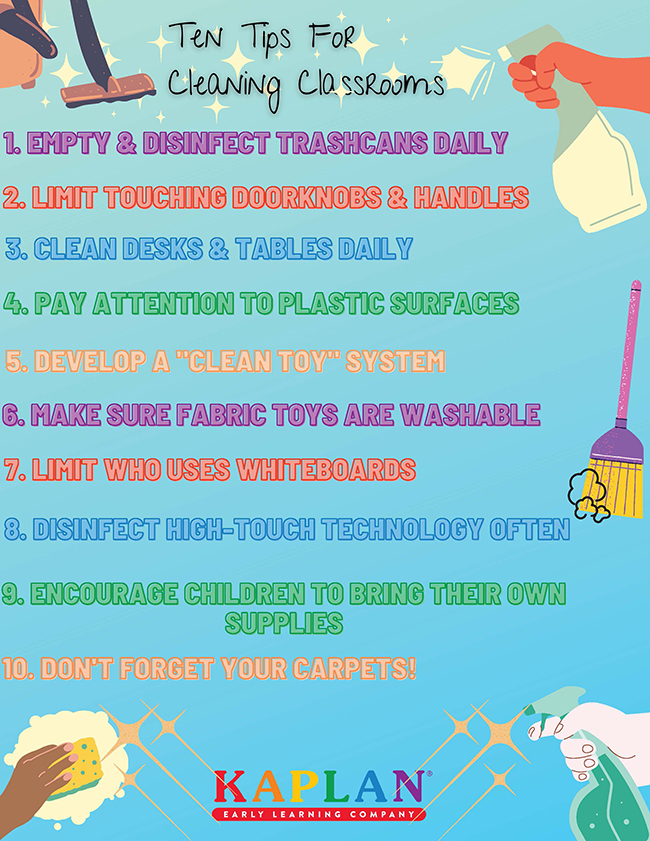
Now more than ever, it is important to create healthy and safe classroom environments for students and teachers alike. Classroom health and safety has always been a priority of educators and families, but the COVID-19 crisis has highlighted the need for safe learning environments, wellness, and an understanding of what steps we can take to prevent the spread of illnesses. Maintaining clean classrooms for children can be both easy and rewarding! Here are 10 Tips for Cleaning Classrooms we recommend to ensure the health and wellbeing of each child in your care.
See below to download your own FREE printable checklist!
1. Empty & Disinfect Trashcans Daily
What we discard in the trash each day can be unpredictable! By emptying and disinfecting classroom trashcans each day, teachers can eliminate one potential way that COVID-19 can spread.
2. Limit Touching Doorknobs & Handles
We now know that one of the many ways COVID-19 spreads is through contaminated surfaces. Teachers should limit the number of children that touch doorknobs and handles each day by requesting that children ask for a grownup's help when they need to open doors or cabinets, etc. Teachers are also advised to disinfect these high-touch areas more than once a day if possible, especially at the beginning and end of each school day.
3. Clean Desks & Tables Daily
Disinfecting tables and desks each day is an important step in preventing contaminated surfaces. Teachers in classrooms with individual desks for each child should allow students to only sit at their own assigned seats. For group tables, assigned seats can also be used to encourage social distancing and help prevent the spread of germs.
4. Pay Attention to Plastic Surfaces
The World Health Organization (WHO) has found that COVID-19 germs can survive for up to 72 hours on plastic and stainless-steel surfaces. For this reason, in classrooms and learning centers it is essential to disinfect any plastic chairs or surfaces on a daily basis.
5. Develop a "Clean Toy" System
Since toys have the potential to be shared by several children each day, it's important to keep them disinfected. Consider implementing a "clean toy" system in your classroom where, if a child wants to play with a new toy, they drop off the toy they just played with into a "played with" bin for the teacher to clean before this toy is passed off to another child.
6. Make Sure Fabric Toys Are Washable
If possible, make sure that the fabric toys in your classroom, such as stuffed animals, are machine washable and dryer safe. Teachers should wash and dry these fabric toys daily if able.
7. Limit Who Uses Whiteboards
Smart boards, whiteboards, and chalkboards should all be disinfected daily, even if teachers are the only ones who use them in the classroom. Teachers should also encourage children to limit their use of the styluses, markers, and chalk that go with these boards in order to prevent the spread of germs.
8. Disinfect High-Touch Technology Often
A thorough disinfection of classroom technology, like computer mice and keyboards and touchscreen devices, each day they are used by students is recommended. In classrooms where computers are used daily, teachers can assign computer for each student when possible, or disinfect each device before being used by another student.
9. Encourage Children to Bring Their Own Supplies
If your classroom has a pencil sharpener, especially one with a handle, this tool should be disinfected daily. However, to prevent the spread of germs from high-touch items like pencil sharpeners and shared art supplies, teachers can request that parents send their child to school with their own pencils, crayons, markers, etc. to limit the spread of germs.
10. Don't Forget Your Carpets!
While carpets cannot technically be disinfected, they can be cleaned! Since COVID-19 is transmittable through air droplets and touch, carpets are a prime spot for germs to settle. Despite being a porous surface, which is less likely to hold the virus for long periods of time, the number of children that walk and play on classroom carpets each day means they should be cleaned as often as possible, if feasible. Carpets should be vacuumed daily with a HEPA filter to trap particles and prevent recirculation. Carpets should also be professionally cleaned as often as your school or center will allow. For smaller carpets, that are machine washable, we recommend washing them weekly.
For more information on preventing COVID-19 in your classroom, visit the World Health Organization's website here .
Keep this checklist handy in your classroom by downloading the FREE printable below!

